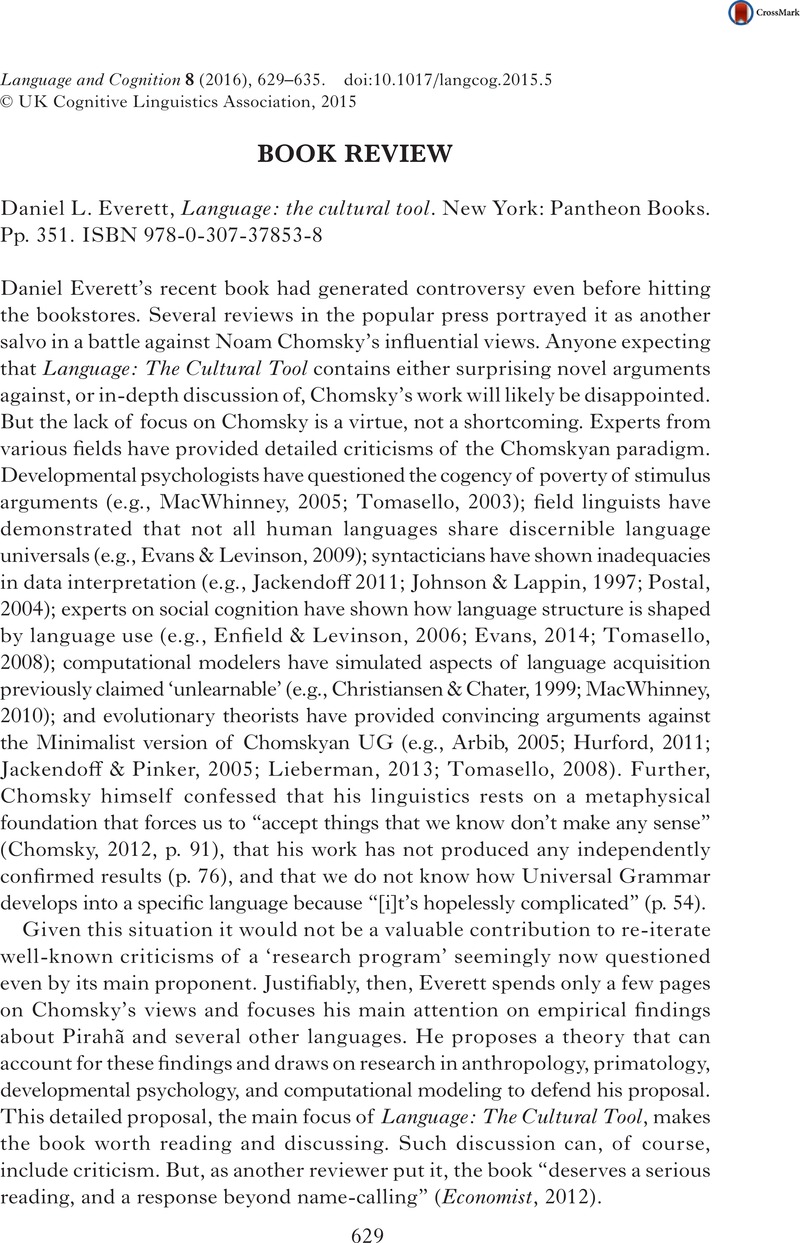No CrossRef data available.
Article contents
Daniel L. Everett, Language: the cultural tool. New York: Pantheon Books. Pp. 351. ISBN 978-0-307-37853-8
Review products
Daniel L. Everett, Language: the cultural tool. New York: Pantheon Books. Pp. 351. ISBN 978-0-307-37853-8
Published online by Cambridge University Press: 16 March 2015
Abstract
An abstract is not available for this content so a preview has been provided. Please use the Get access link above for information on how to access this content.

- Type
- Book Review
- Information
- Copyright
- Copyright © UK Cognitive Linguistics Association 2015
References
references
Arbib, M. A. (2005). From monkey-like action recognition to human language: an evolutionary framework for neurolinguistics. Behavioral and Brain Sciences, 28, 105–167.Google ScholarPubMed
Chomsky, N. (2012). The science of language – interviews with James McGilvray. Cambridge: Cambridge University Press.CrossRefGoogle Scholar
Christiansen, M. H., & Chater, N. (1999). Toward a connectionist model of recursion in human linguistic performance. Cognitive Science, 23, 157–205.CrossRefGoogle Scholar
Economist (2012). Understanding language talk, talk. Online: <http://www.economist.com/node/21550238> (last accessed 3 March 2015).+(last+accessed+3+March+2015).>Google Scholar
Enfield, N., & Levinson, S. (2006). Roots of human sociality: culture, cognition, and interaction. Oxford: Berg.Google Scholar
Evans, N., & Levinson, S. (2009). The myth of language universals: language diversity and its importance for cognitive science. Behavioral and Brain Sciences, 32, 429–448.CrossRefGoogle ScholarPubMed
Evans, V. (2014). The language myth: why language is not an instinct. Cambridge: Cambridge University Press.CrossRefGoogle Scholar
Gil, D. (2009). How much grammar does it take to sail a boat? In Sampson, G., Gil, D., & Trudgill, P. (Eds.), Language complexity as an evolving variable (pp. 19–33). Oxford: Oxford University Press.CrossRefGoogle Scholar
Hurford, J. (2011). The origins of grammar: language in the light of evolution. Oxford: Oxford University Press.Google Scholar
Jackendoff, R. (2011). What is the human language faculty? Two Views. Language, 87, 586–624.CrossRefGoogle Scholar
Jackendoff, R., & Pinker, S. (2005). the nature of the Language Faculty and its implications for the evolution of language (reply to Fitch, Hauser, and Chomsky). Cognition, 97, 211–225.CrossRefGoogle Scholar
Johnson, D., & Lappin, S. (1997). A critique of the Minimalist Program. Linguistics and Philosophy, 20, 273–333.CrossRefGoogle Scholar
Katz, J. J. (1981). Language and other abstract objects. Totowa, NJ: Rowman and Littlefield.Google Scholar
Katz, J. J. (1996). The unfinished Chomskyan revolution. Mind and Language, 11, 270–294.CrossRefGoogle Scholar
Katz, J. J., & Postal, P. M. (1991). Realism vs. conceptualism in linguistics. Linguistics and Philosophy, 14, 515–554.CrossRefGoogle Scholar
Lieberman, P. (2013). The unpredictable species: what makes humans unique. New York: Princeton University Press.CrossRefGoogle Scholar
MacWhinney, B. (2005). A unified model of language acquisition. In Kroll, J. F. & De Groot, A. M. B. (Eds.), Handbook of bilingualism: psycholinguistic approaches (pp. 49–67). New York: Oxford University Press.Google Scholar
MacWhinney, B. (2010). Computational models of child language learning. Journal of Child Language, 37, 477–485.CrossRefGoogle ScholarPubMed
Postal, P. M. (2004). Skeptical linguistic essays. New York: Oxford University Press.CrossRefGoogle Scholar
Tomasello, M. (2003). Constructing a language: a usage-based theory of language acquisition. Cambridge, MA: Harvard University Press.Google Scholar
Tomasello, M. (2008). Origins of human communication. Cambridge, MA: MIT Press.CrossRefGoogle Scholar



